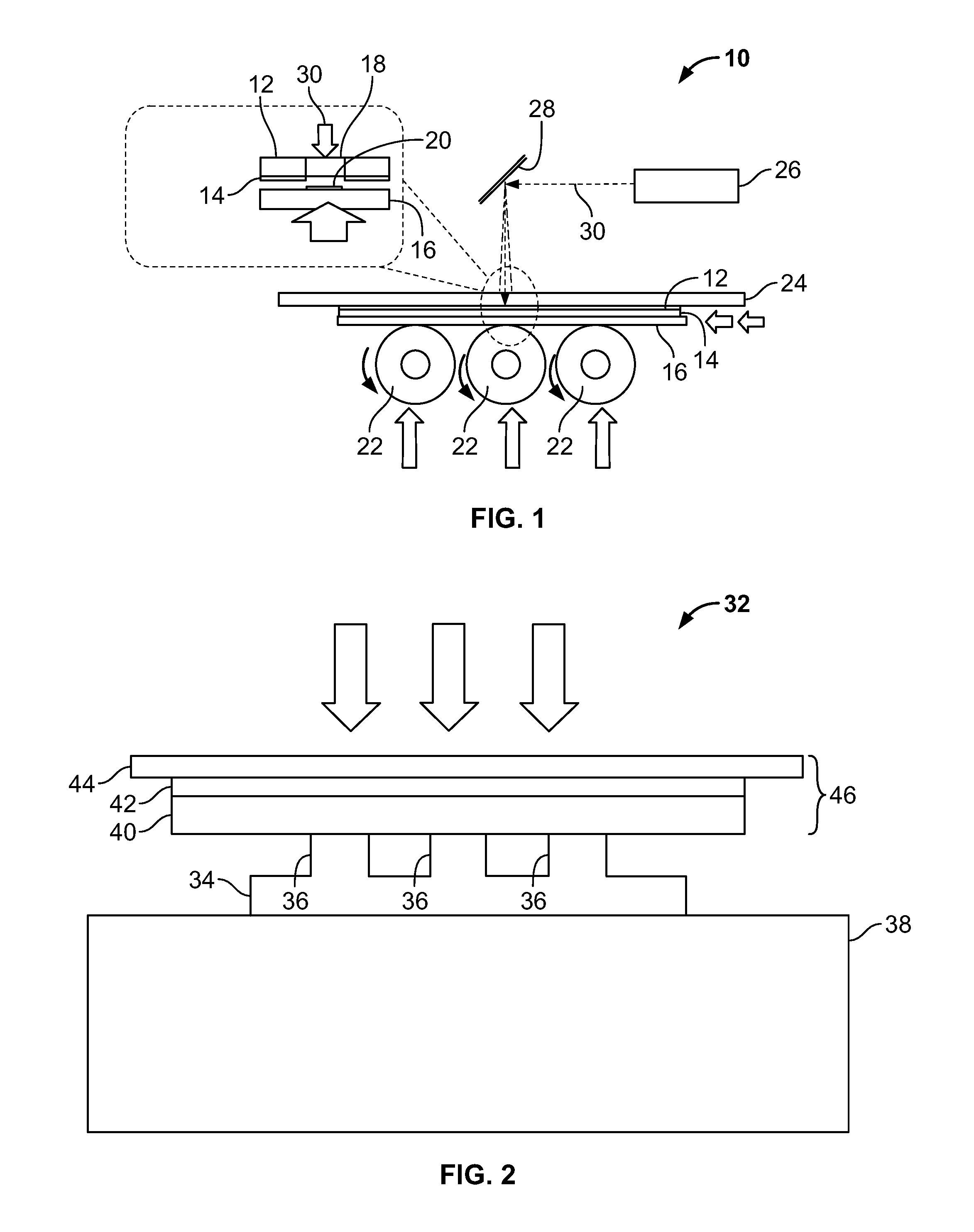High-throughput graphene printing and selective transfer using a localized laser heating technique
a laser heating and high-throughput technology, applied in the field of nanofabrication of graphene patterns, can solve the problems of long processing time, low yield, high processing cost, etc., and achieve the effect of facilitating high-speed and high-throughput graphene pattern printing
- Summary
- Abstract
- Description
- Claims
- Application Information
AI Technical Summary
Benefits of technology
Problems solved by technology
Method used
Image
Examples
experimental verification
[0016]The following experiments (i.e., Experiment 1 and Experiment 2) have been conducted, and verify the utility of the present invention. Good uniform transfer of large-area graphene on the targeted substrate using a roller press was demonstrated (Experiment 1), and local heating of the thermal release tape was observed to consistently transfer graphene only in the locally heated areas (Experiment 2). The results of Experiments 1 and 2 are summarized below.
experiment 1
Method
[0017]Large-area graphene transfer onto a substrate was demonstrated using a roller-press apparatus. Silicone rollers were used to press multiple layers of large-area graphene adhered to a thermal release tape (thermal release tape 3195MS, Semiconductor Equipment Corporation) against a film of PET polymer at high temperatures (i.e., temperatures equal to or greater than about 100° C.), and a uniform pressure in the range of about 5 psi to about 10 psi. At high temperatures, the thermal release tape lost its adhesive properties and the graphene layer was transferred onto the PET substrate. Three temperatures were tested (i.e., 100° C., 120° C., and 150° C.). Care was taken to ensure that the PET film did not soften during the transfer process.
[0018]Homogeneous transfer of large-area graphene was observed at all three temperatures. The best transfer, based on the amount of large-area graphene transferred to the substrate and the uniformity of the large-area graphene transferred,...
experiment 2
g and Transfer Method
[0020]The feasibility of local graphene transfer from large-area graphene to a substrate was demonstrated by locally heating thermal release tape having large-area graphene adhered thereto. FIG. 2 is a schematic illustration of the experimental set-up 32 used for this experiment. Turning to FIG. 2 for reference, a silicon oxide wafer 34 with a pattern of 1 mm-diameter circular pedestals 36 was placed on a hot plate 38 and heated to 150° C. A thermal release tape 40 (thermal release tape 3195MS, Semiconductor Equipment Corporation) having large-area graphene 42 adhered thereto was placed with the graphene 42 in contact with a silicon substrate 44. The resulting stack 46 of substrate-graphene-tape was then placed carefully onto the heated circular pedestals 36 with the thermal release tape 40 in contact with the pedestals 36. Downward pressure was applied to the stack 46 using weights (not shown) placed on top of the silicon substrate 44, thereby pressing the ther...
PUM
| Property | Measurement | Unit |
|---|---|---|
| temperature | aaaaa | aaaaa |
| temperature | aaaaa | aaaaa |
| temperatures | aaaaa | aaaaa |
Abstract
Description
Claims
Application Information
 Login to View More
Login to View More - R&D
- Intellectual Property
- Life Sciences
- Materials
- Tech Scout
- Unparalleled Data Quality
- Higher Quality Content
- 60% Fewer Hallucinations
Browse by: Latest US Patents, China's latest patents, Technical Efficacy Thesaurus, Application Domain, Technology Topic, Popular Technical Reports.
© 2025 PatSnap. All rights reserved.Legal|Privacy policy|Modern Slavery Act Transparency Statement|Sitemap|About US| Contact US: help@patsnap.com


